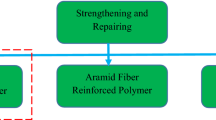Abstract
It is quite challenging to use tunnel segment as a repair experiment object due to its large size, the difficulty of installation, and loading inconvenience. To tackle this problem, a 45° symmetrical-bevel RC plate has been employed to substitute segment and conventional RC plate, and to investigate the mechanical behavior of secondary crack problems for concrete segments after repair by polymeric matrix and fiber reinforcement polymers (FRPs). Moreover, elaborate five numerical models of segments were established by means of experiments and 3D finite element method. The prediction results indicated that the mechanical properties of using 45° symmetrical-bevel RC plate were in good agreement with the concrete segments (81.30%). In contrast, those using conventional RC plate showed a larger disagreement (57.49%). Versus and after repair by PM and FRPs, the secondary cracks of concrete segments were improved by 2.86–29.52% of compressive strength compared with the primary cracks. It demonstrated that the experimental results and the simulation results matched well (close to min. 87.89%).







Similar content being viewed by others
References
Alam MA, Mohammed W, Bakkar S, Beddu S (2018) Prevention of premature failures of plate bonded flexurally strengthened RC slab using end anchor and connector. Alex Eng J 57(1):287–299
Azarm R, Maheri MR, Torabi A (2017) Retrofitting RC joints using flange-bonded FRP sheets. Iran J Sci Technol Trans Civ Eng 41(1):27–35
Bennegadi ML, Hadjazi K, Sereir Z, Amziane S, El Mahi B (2016) General cohesive zone model for prediction of interfacial stresses induced by intermediate flexural crack of FRP-plated RC beams. Eng Struct 126:147–157
Bhuvaneshwari P, Mohan KSR (2017) Strength analysis of reinforced concrete beams affected by fire using glass fiber sheet and PP fiber ECC as binders. Iran J Sci Technol Trans Civ Eng 41:37–47
Chen WF, Mizuno E (1990) Nonlinear analysis in soil mechanics: theory and implementation (developments in geotechnical engineering), 3rd edn. Elsevier, Amsterdam
Chen W, Pham TM (2018) Experimental study of flexural behaviour of RC beams strengthened by longitudinal and U-shaped basalt FRP sheet. Compos B Eng 134:114–126
Cheng WC, Ni J-C (2009) Feasibility study of applying SOFO optical fiber sensor to segment of shield tunnel. Tunn Undergr Space Technol 24(3):331–349
Conforti A, Tiberti G, Plizzari GA, Caratelli A, Meda A (2017) Precast tunnel segments reinforced by macro-synthetic fibers. Tunn Undergr Space Technol 63:1–11
Coronado CA, Lopez MM (2006) Sensitivity analysis of reinforced concrete beams strengthened with FRP laminates. Cement Concr Compos 28:102–114
Ding Y, Liu H, Pacheco-Torgal F, Jalali S (2011) Experimental investigation on the mechanical behaviour of the fiber reinforced high-performance concrete tunnel segment. Compos Struct 93:1284–1289
Dundar C, Tanrikulu AK, Frosch RJ (2015) Prediction of load-deflection behavior of multi-span FRP and steel reinforced concrete beams. Compos Struct 132:680–693
Gao PW, Xu SY, Chen X (2013) Research on autogenous volume deformation of concrete with MgO. Constr Build Mater 40:998–1001
Gong C, Ding W, Mosalam KM, Günay S, Soga K (2017) Comparison of the structural behavior of reinforced concrete and steel fiber reinforced concrete tunnel segmental joints. Tunn Undergr Space Technol 68:38–57
Hosseini M, Amir A, Beiranvand P (2016) Numerical analysis of reinforced concrete beams containing bending and shear opening and strengthened with FRP sheet. Eng Solid Mech 4:145–152
Industry Standard of the People’s Republic of China (2012) Repair of concrete structures using polymer cement mortar (JG/T 336-2011). Ministry of Housing and Urban–Rural Development of the People’s Republic of China (MOHURD), Beijing
Jiang JF, Wu YF (2012) Identification of material parameters for Drucker–Prager plasticity model for FRP confined circular concrete columns. Int J Solids Struct 49(3–4):445–456
Karnovsky IA, Lebed O (2010) Advanced methods of structural analysis. Springer, Berlin
Ministry of Commerce of the People’s Republic of China (1999) Code for design of steel-concrete composite structure (DL/T 5085-1999). China Electric Power Press, Beijing
Ministry of Construction of the People’s Republic of China (2003) Code for design of steel structures China architecture and building press (GB 50017–2003). China Architecture and Building Press, Beijing
Ministry of Housing and Urban–Rural Development of the People’s Republic of China (2015) Code for acceptance of constructional quality of concrete structures (GB 50204-2015). MOHURD, Beijing
Ministry of Housing and Urban–Rural Development of the People’s Republic of China (2017) Standard for test method of mechanical properties on ordinary concrete (GB/T 50081-2016). MOHURD, Beijing
Multiphysics COMSOL (2017) Concrete beam with reinforcement bars. COMSOL Multiphysics 5:2a
Ottosen NS (1977) A failure criterion for concrete. Am Soc Civ Eng Eng Mech Div J 103(4):527–535
Ottosen NS, Ristinmaa M (2005) The mechanics of constitutive modelling. Elsevier, Amsterdam
Radfar S, Foret G, Saeedi N, Sab K (2012) Simulation of concrete cover separation failure in FRP plated RC beams. Constr Build Mater 37:791–800
Standard for Power Industry of P. R. China (2001) Test code on polymer modified cement mortar (DL/T 5126-2001). China Electric Power Publishing House, Beijing
Thai HT, Nguyen TK, Vo TP, Ngo T (2017) A new simple shear deformation plate theory. Compos Struct 171:277–285
Uddin N (2010) Blast protection of civil infrastructures and vehicle using composites. Elsevier, Amsterdam
Zhang Z, Yan P (2017) Hydration kinetics of the epoxy resin-modified cement at different temperatures. Constr Build Mater 150:287–294
Acknowledgements
The authors would like to acknowledge the High-level Talent Project Funding Scheme of Jiangsu (XCL-CXTD-007), Postdoctoral Fund of China (2018M630559, 2014M551588), the Fundamental Research Funds for the Central Universities (NS2015010), and the Traffic Construction Science and Technology Project of Shanxi (16-2-08) for its financial support in this project.
Author information
Authors and Affiliations
Corresponding author
Rights and permissions
About this article
Cite this article
Eng, T.Z., Wu, X., Gao, P. et al. Secondary Cracks and Mechanical Behavior Prediction of Concrete Segments After FRP Confinement. Iran J Sci Technol Trans Civ Eng 43, 769–779 (2019). https://doi.org/10.1007/s40996-018-0219-8
Received:
Accepted:
Published:
Issue Date:
DOI: https://doi.org/10.1007/s40996-018-0219-8




